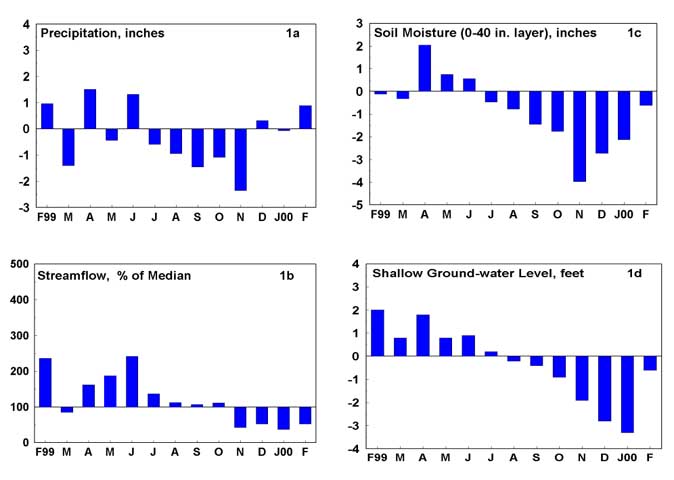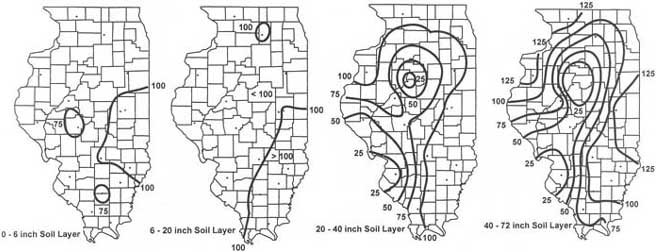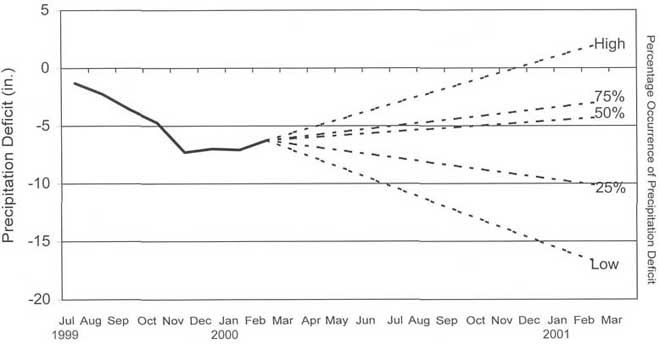ASSESSMENT OF THE POTENTIAL FOR DROUGHT STRESS IN ILLINOIS
SUMMARY
During July-November 1999, Illinois experienced increasingly dry conditions, with accumulated deficits in precipitation of 7 inches averaged statewide. This deficiency in precipitation resulted in below average soil moisture, streamflow, reservoir levels, and ground-water levels. Average to slightly-above-average precipitation during the winter months has somewhat alleviated concerns over the state's water-sensitive enterprises. However, future precipitation deficits, should they occur, could result in serious water-supply problems across the state. An analysis of past droughts indicates that an additional rainfall deficit of about 4 inches would trigger a situation of concern. Historical precipitation data of similar dry periods indicate that there is almost a 50 percent chance of current precipitation deficits continuing, and a 25 percent chance of severe precipitation deficits developing within the next 12 months - much larger risks than in an "average" year. However, there is no way to accurately predict this type of event given forecasting methods presently available. In view of these concerns, managers and users of Illinois water supplies are advised to be aware of the risk of drought and to track the evolving situation.
CURRENT SITUATION
The deficit in precipitation across Illinois in the second half of 1999 was substantial (Fig. 1a), lowering streamflow, reservoir levels, ground-water levels, and soil moisture, thus making these Illinois water resources vulnerable to future precipitation deficits, should they occur. River streamflows (Fig. 1b), soil moisture (Fig. 1c), and shallow ground-water levels (Fig. 1d) responded on different time intervals, but in total revealed a steady trend of declining water resources across the state. Illinois is now in a position such that continued, prolonged precipitation deficits could place the state's water resources and uses at potentially stressful levels during upcoming spring and summer months. These dry conditions in Illinois are part of a much larger regional area of dry weather that stretches across much of the Midwest and High Plains.
Over the last three months, parts of southern Illinois have received precipitation totals that were substantially above average and have reduced the stress on water resources in that part of the state. Nevertheless, stream flows have remained below normal in central and southern Illinois. Most water supply reservoirs are slightly below average levels and several are drawn down by 5 or more feet, which is unusually low for this time of year.
Ground-water levels in shallow private wells (average levels of 10 to 20 feet) have recently shown significant increases in areas where there has been average precipitation. Greatest shortfalls in ground water and soil moisture (Fig. 2) are currently located in central and southwestern Illinois. Widespread problems have been reported with shallow private wells. There have not been problems reported with deeper public water supply wells.
THE FUTURE
Precipitation is highly variable in time and space, and there is no way to accurately and precisely predict precipitation amounts months ahead, given forecasting methods presently available. However, the past can be a useful guide to the future. We know that, typically, extended droughts last for 18 to 20 months and occur over a large geographical area.
Streamflow records over the last 85 years indicate droughts of sufficient intensity to create serious streamflow deficiencies occur on average about once every 12 years. Analysis of historical precipitation records since 1895 suggests that rainfall deficits since July 1999 are similar in magnitude to early stages of many historic droughts, including those in 1908, 1917, 1930, 1953, and 1976. [The drought of 1988 was different in that it occurred in late spring and early summer, without having been foreshadowed by large precipitation deficits in the second half of 1987.]
If precipitation comparable to these past episodes occurs during the next few months, then there is a risk of water shortages in parts of the state during the upcoming spring and summer. A short-term increase in precipitation, as has been experienced in the past two to three months, may not be indicative of a true recovery.
The solid line in Figure 3 shows the accumulated precipitation deficit from July 1999 to February 2000. In the last 105 years, there have been 20 dry periods similar to this one. The dashed lines in Figure 3 show the spread of rainfall trends for the subsequent 12 month periods following these 20 dry periods. These are simplified trend lines and do not show the month-to-month variations. These data show that the wettest 12 month period (the HIGH case) turned the precipitation deficit into a slight surplus. In the top 25 percent of the cases (75 percent line), precipitation deficits were reduced. In about 50 percent of the cases (50 percent line), precipitation deficits remained fairly steady. In the lowest 25 percent of the cases (25 percent line), precipitation deficits grew to about 10 inches or more. The driest 12 month period ( the LOW case) resulted in a cumulative precipitation deficit of about 17 inches.
The bottom line is that there is almost a 50 percent chance of current precipitation deficits continuing, and a 25 percent chance of severe precipitation deficits developing in the next 12 months - much larger risks than in an "average" year.
POTENTIAL IMPACTS
a. Agriculture
Given average rainfall between now and the time of planting, soil moisture should be adequate
throughout the state for crop establishment. Reemergence of dry conditions in summer would have a
negative impact on crops as they begin to draw on limited soil moisture in lower soil layers. Regions that
are initially dry would encounter difficulties more quickly, if below average precipitation is widespread,
or if long time periods ensue without significant rainfall.
b. Public water supplies
The impacts of drought on public water-supply reservoirs vary among locations. Most water
systems in Illinois are adequately designed to provide a reliable water supply during severe drought
conditions. Of the reservoirs that are currently below normal, most are expected to fully recover before
the end of the spring season. Others may not fully rebound to normal levels, but they have sufficient
water to provide their communities with the water needed for the next year. There are a few water
supply reservoirs that will be monitored in the upcoming months for signs that possible shortages could
occur later this year. Many of these supplies have begun looking at possible options and supplemental
water supplies.
In areas that receive average precipitation, ground-water levels in shallow public and private wells should continue to rise. However, should below average precipitation occur, there will be increased concern for these water supplies.
March 8, 2000
PREPARED BY
Illinois State Water Survey
Illinois Department of Natural Resources
2204 Griffith Drive
Champaign, IL 61820
Chief, Derek Winstanley
Phone: 217/244-5459
Fax: 217/333-4983
e-mail: dwinstan@uiuc.edu
http://www.sws.uiuc.edu
Please direct press inquiries on public water supplies to:
Joan Muraro, Public Information Officer
Bureau of Water, Illinois EPA
217/785-7209
Please direct technical inquiries on public water supplies to:
Roger Selburg or Bud Bridgewater
Division of Public Water Supplies
Illinois EPA
217/785-8653

Figure 1. March 1, 2000 statewide departures from normal in Illinois
Figure 2. March 1, 2000 observed percent-of-normal soil moisture (1985-1995 mean).
Figure 3. Precipitation deficit from July 1999 to February 2000 (solid line) and probabilities of
precipitation trends based on historical analysis of 20 similar dry periods (dashed lines).

